|
How to transfer DVD to your PSP directly?
ImTOO DVD to PSP Converter is a powerful tool for PSP that can
transfer DVD to your PSP directly. Here is the Guide:
1. Run DVD to PSP Converter and load DVD. Please choose "Add
DVD Folder" in the 'File' menu or directly press the "DVD" button in the main interface, then select your DVD Drive in the
pop-up window and press the "OK" button.
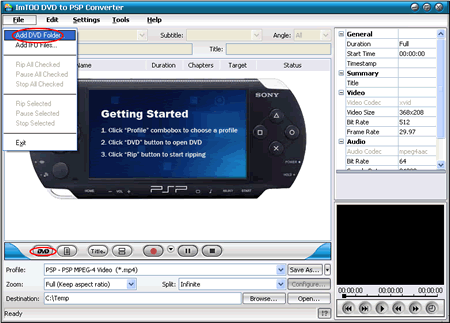
2. You can choose to convert either any chapters within a file
or the entire file at will.
* If you want to convert the entire file, please follow this way:
(1) Set output format:
In
"Profile" drop down list box, you may select output format. The software allows setting different output formats according
to different files.
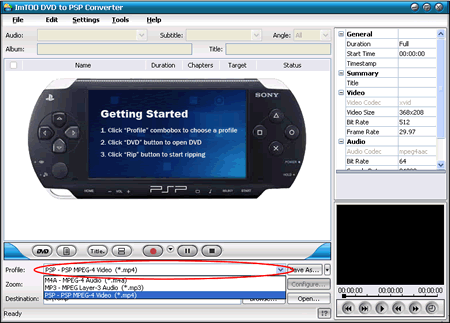
(2) Set conversion mode (Optional). After selecting certain output
format, the right column will show its general standard. Clicking certain settings such as 'Zoom', 'Split', 'Destination'
and 'Title' etc, you may set it. |
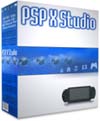
Click for more info
|
|
Tips: you can set "Bit Rate" by choosing the rate given,
such as "512". And the higher the Bit Rate you choose the better the picture you will get. Certainly, you can keep all the
above options default without any change.
(3) Start conversion:
Finally, selected the chapter you want to convert
and start conversion by right-clicking the file name and selecting 'Rip Selected' under the menu.
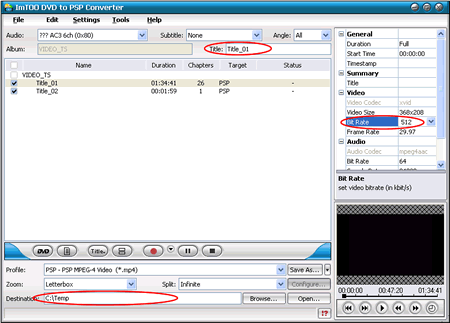
* If you want to convert just a chapter, here is the way: After
your DVD is loaded into ImTOO DVD to PSP Converter, please select the file name and click the "Show Chapters" button in the
main interface and then you will see all the chapters within this file. Please select the chapter you want to convert and
do the same as the above (1), (2) and (3).
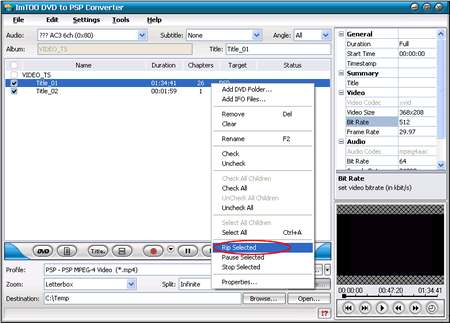
3. And then you will get a file that is ready to be played on
your PSP. But how do you add it to your PSP? Here is the way:
(1) Make sure your PSP is successfully connected to the
computer through USB, check the Connection status in your PSP “setting” menu.
(2)Choose the “PSP Video Manager” in the “Tools”
menu.
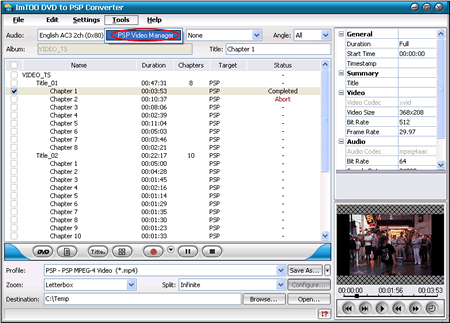
(3) Select the converted file you want in the pop-up window and
click “Copy” to pull it to your PSP.
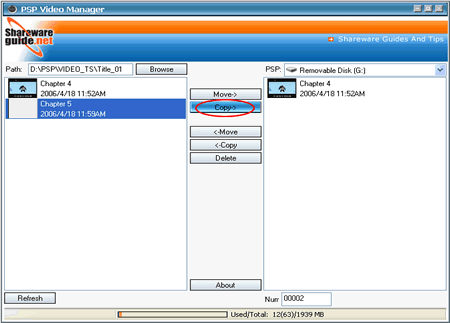
Free Trial Software
Click here to download the ImTOO PSP Video Converter trial version
Please Note: You may be able to find some better software on
our "Other software" page but this is the only piece of software that has its own tutorial. |
|
 |
|
How to take apart your PSP
In this lesson you are going to find out how take apart your
PSP. Please Note: This will make your PSP warranty void!
1. The Gear
Before attempting to take apart any
electronic device, make sure you have the right gear and location. You don't want to lose screws or other parts to kids, dogs,
or a sudden blast of air. For the PSP you really only need one small flat head screwdriver that you can use for prying, and
a Philips head screwdriver to remove the screws. A pen/paper might also be useful for remembering where the screws go. If
you are a professional, then you might want to ground yourself using a static strap to prevent any sudden static discharges
from killing your PSP.
2. Removing the cover
The first step to taking
apart any device is to locate the screws keeping the outer shell on the device. In the case of the PSP, you will have to remove
three screws. The first two are easy to find and are on the back right side of the PSP near the Duo stick slot (black). The
third screw is on the bottom side of the PSP right in the center of the system. The final two screws are actually hidden away
in the battery cavity.
You will be able to see one black screw and one silver screw
once the battery is removed. You can remove both of them, but it is the black screw that is responsible for keeping the case
together. The silver screw is there to keep the LCD holder in place.
The final screw is actually under the PSP Void warranty sticker
that is at the lower side of the battery cavity. Don't touch that warranty sticker unless you are sure you want to go inside.
It is not easy to get one of these off without causing the sticker to show evidence of tampering. With the sticker removed,
you will once again see a black and silver screw. Remove the black one at this time, and keep in mind the silver screw for
later. Once the black screw is removed, you should be able to lift the top of the PSP case off the device and view the internals
(see Figure 1 for illustration).
3. Removing the LCD
With the cover off, the next step appeared to be to remove the LCD display. After poking
around for a few seconds, I noticed the there was a button bar across the bottom of the LCD that would have to be removed.
This pops off easily by lifting the silver catch on the left side of the display. You can then carefully remove the bar by
lifting the tan catch on the connector and pulling out the circuit strip.
See figure 1 below - PSP with top cover removed
|

Click for more info
|
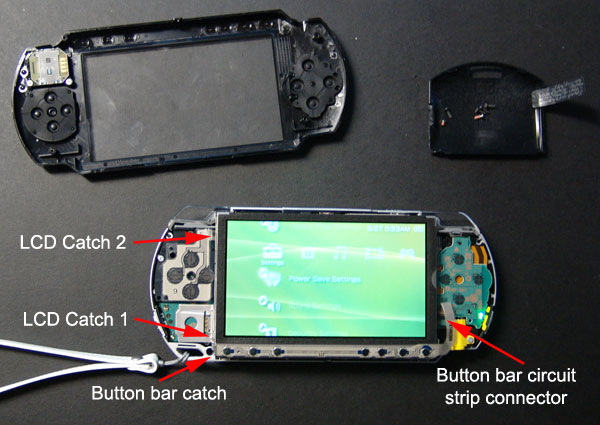
Removing the screen is a bit more challenging. I wasn't sure
at first where to start, but eventually trusted my gut instinct and went with the brute force method. My target was the left
lower corner of the LCD tray. You insert a very narrow screwdriver in between the screen and the metal piece holding the analog
joystick board (LCD Catch 1 in Figure 1). Then pry the screen up slowly and the metal wedge should pop out of the catch in the lower left part of the display tray.
Next do the same on the top left side of the display (LCD Catch 2 in Figure 1). This should allow you to wiggle the screen up and out. Just be careful not to pull to fast or hard because the display
is connected to a circuit board underneath with two circuit strips (Figure 1). Now that the screen is released from its holder, I wonder if my screen can become adjustable, as illustrated in Figure 2.
See figure 2 below - Angled LCD screen
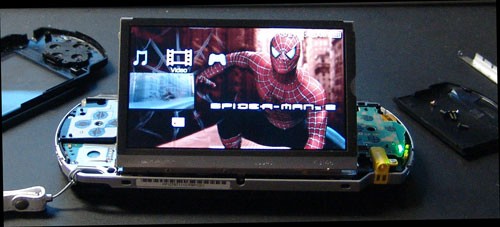
With the LCD out of the tray, we need to remove it from the PSP.
This is accomplished by removing the circuit strips from the main board of the PSP. To do this, first lift the black part
of the connector on each strip. The long connector lifts from the bottom, and the short connector lifts from the top (Figure 3 for details). Before removing these connectors, make sure you take out the battery. You don't want any current flowing through
the PSP causing you problems!
See figure 3 below - Removing the LCD screen

Next, you need to remove the metal tray that held the LCD, which
is tricky because it is linked to the UMD release on the top of the PSP. So, carefully make sure that you have removed all
visible screws that hold the tray down (note where each screw is to be placed when you rebuild the PSP, and also make sure
you remove the two screws from the battery cavity (these might have been removed by you earlier). These will be silver screws,
not the previously removed black screws. Once all the screws are removed, open the UMD door and then lift the display tray
off the PSP. Figure 3 shows you the general location of the screws.
4. The Wi-Fi Antenna
Earlier I had noticed what
I thought was an antenna on the right side of the PSP under the PlayStation controller circuit board. To verify this, I slowly
pried the circuit board over the upper catch and lifted it up off the PSP. This piece could be fully removed if you wanted
to take out the Right trigger button, but I just wanted it out of the way. To achieve this, I simply lifted the circuit strip
connector and flipped the controller circuit board over the top of the PSP. This gave me a clear shot of the antenna and its
connecting wire, as detailed below (Figure 4). With this now laid bare, it would be fairly easy to add my own external antenna. However, if the WNIC had a connector on
it that I could plug into, the embedded antenna could be complete stripped!
See figure 4 below - WiFi antenna and connecting wire
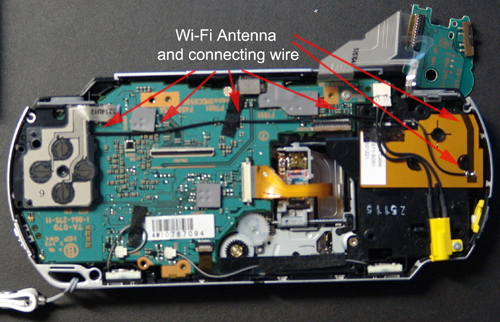
The Main Circuit Board
Next I targeted the main circuit
board from the PSP. This proved to be difficult. First I had to remove one screw previously hidden by the LCD tray. Then I
had to remove the left side PSP controller, which was snuggly inserted between the circuit board and the case of the PSP.
Removing this once again involved lifting a circuit strip connector, but by now you should be familiar with how this process
works. Next I had to disconnect a circuit strip located near the bottom of the PSP that connects the UMD drive to the main
board. Once this piece was disconnected, I slowly worked the circuit board up off the PSP. As I learned, the board was connected
to the rest of the PSP via a male/female connector. This connector is located almost directly under the LCD connectors on
the circuit board. As a result, you can leverage the circuit board up by using the upper left of the PSP to push the board
out of the male/female plug. Figure 5 shows you what the PSP should look like at this point. You can optionally remove the small connectors at the bottom of the
PSP that connect up to the speakers. However, for my purposes, I left these connected and simply flipped the main board over
once it was removed.
See figure 5 below - PSP without circuit board
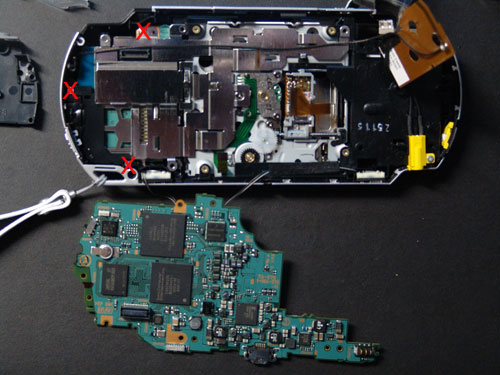
5. Getting to the Wi-Fi Card
I was still not at
the Wi-Fi card! Beneath the main circuit board is a grounding/protector plate. This is easy to remove, and only requires the
removal of three more screws, as indicated with red X's in Figure 5. Once these screws are out, you first have to take out the plastic black piece, which then allows the silver shield to be
removed. I could finally see the Wi-fi card, which simply lifted out the PSP. As I had hoped, the antenna was indeed connected
to the card via a socket connector. In addition, I also noted that my WNICs hardware address was stamped onto the cards surface.
Finally, I also should note that the Duo stick slot is also integrated into the same circuit board as the WNIC.
Figure 6 below shows the PSP complete disassembled in all its
glory!

Please note: We take no responsibility for you
breaking your PSP whilst following these instructions.
Full credit for these instructions goes to Seth Fogie of www.informit.com! |
|
|
 |
|
How to use your MAC to play PSP games over the web
In this lesson you are going to find out how to use your MAC
PC to play PSP games over the web.
Introduction
Before attempting the following setup, please turn off firewalls,
your airport, and make sure your Mac is connected to the internet via ethernet. Also please note that I have been unsuccessful
in setting this up on one of the original Airport cards. As far as I can tell an Airport Extreme is required. This is the
ONLY way it will work. If you cannot connect via ethernet...sorry. I suppose it's possible to have another WiFi card, but
I've not seen any USB WiFi cards compatible with Mac.
Some have said the PSP Setup step is not required. I've had conflicting
views where some can connect regardless o f channel but also some who cannot. Try setting things up without doing the PSP
step first...if it doesn't work right for some reason, then change the PSP settings.
PSP Setup
1. On the Home screen go to the settings toolbox on the far left.
2. Select the Network Settings option
3. Select Adhoc
4.
Select 1ch and press Circle
5. Press Circle again
to save the settings
6. I'm not entirely certain this
is required, but I believe it is. It is possible that 1ch users cannot play with 6ch users so it may be necessary to change
this setting as needed.
....Moving on to the next section of PSP setup.
7. Load a game with wifi capabilities. (Note: I used WipeOut,
so this may be different for some of you. If you are using WipeOut you will see the same SSID broadcast...otherwise your Network
ID you connect to will be different.)
8. Turn on your
WiFi switch and get to a point in the game where the WiFi remains active (green WiFi light flashing). In Wipeout this is the
Multiplayer screen. In other games, you may be required to tell the PSP to host a game to keep the WiFi active long enough.
9. Leave the PSP hosting |

Click for more info
|
|
MacOSX Setup
1. Start the Kaid app but do not click the Kaid icon and tell
it to "Start Kaid"
2. Click the Kaid icon and open
the Kaid preferences and set them to the following (use your own username)
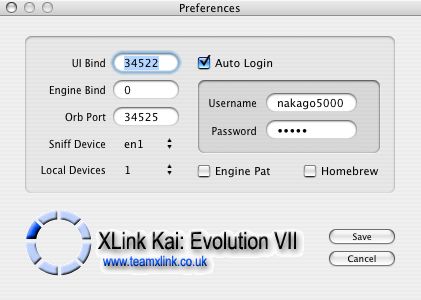
3. Leave Kaid off for now, though the application may remain
open
4. Click on your AirPort in the Menu bar and
turn the Airport back on
5. Select the PSPxxxxxxxxxxxxx
Network that looks like the following:
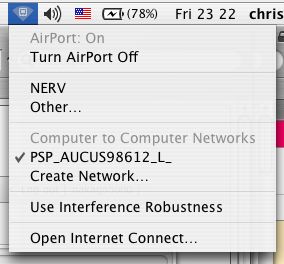
Now you may Start Kaid. Load Amaryllis. Leave all settings here
alone except your login information. (Setting Kaid to auto-login does not mean Amaryllis is supposed to auto-login. Do not
panic.)
Once you are in Amaryllis, goto the consoles
tab on the right hand side of the screen in the drawer. It should look like the following. (0 consoles lists because much
of the OSX software is left incomplete. Just because that does not list the PSP as a console does not mean it will not connect.
Of course that is a different case with the PC version for those of you who have tried.)
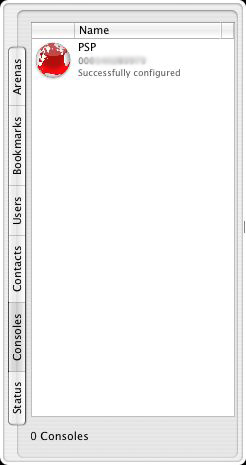
Now you may stop hosting your game on your PSP. You will need
to start hosting a new game in order for it to broadcast in Kaid. Also please note that if you turn of your PSP you will need
to turn off your airport, reconnect to the network, and load kaid again. If you change games, the network will be different,
and you will also need to restart all of the above. As a rule of thumb, PSP Host->Connect Airport->Start Kaid.
This
has worked flawlessly for me and several others. Unfortunatly I dont own every PSP game so I cant test them all. I have however
tested on Ridge Racer and Wipeout and they both work perfectly. |
|
 |
|
|
|



